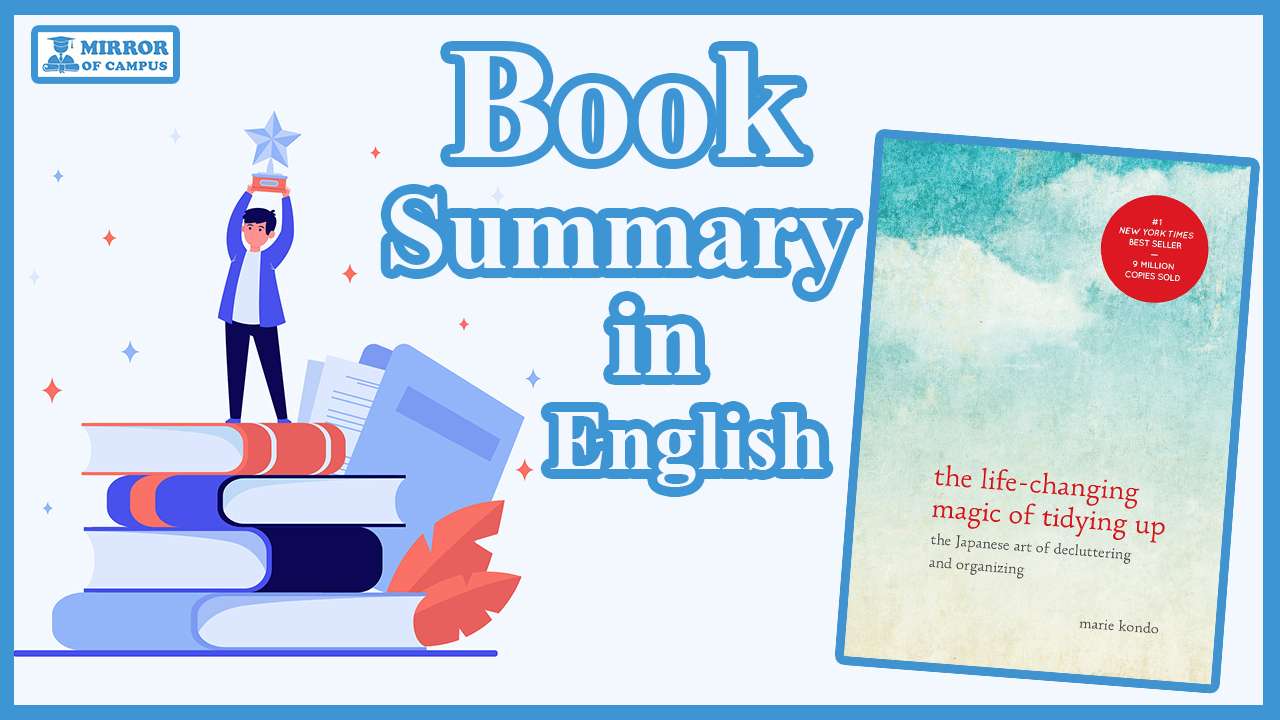Table of Contents
ToggleIntroduction
The Life-Changing Magic of Tidying Up by Marie Kondo is a book that has taken the world by storm. It has become a bestseller and has inspired millions of people to declutter and organize their homes. The book offers a unique approach to tidying up, known as the KonMari Method, which focuses on keeping only the items that spark joy in your life.
Decluttering and organizing may seem like mundane tasks, but they can have a profound impact on our overall well-being. A cluttered and disorganized space can lead to feelings of stress, anxiety, and overwhelm. On the other hand, a tidy and organized space can create a sense of calm and peace. By decluttering and organizing our homes, we can create a happier and more harmonious environment for ourselves and our families.
The KonMari Method: What is it and how does it work?
The KonMari Method is a decluttering and organizing system developed by Marie Kondo. It is based on the principle of keeping only the items that spark joy in your life. The method involves going through your belongings category by category, rather than room by room, and making decisions about what to keep and what to let go of based on whether or not an item brings you joy.
What sets the KonMari Method apart from traditional decluttering methods is its focus on joy. Instead of focusing on what to get rid of, the method encourages you to focus on what to keep. By only keeping items that bring you joy, you can create a space that is filled with things that you love and that make you happy.

The Importance of Decluttering: Why it’s essential for a happier life
Clutter can have a negative impact on both our mental and physical health. Studies have shown that living in a cluttered environment can increase stress levels and contribute to feelings of anxiety and overwhelm. Clutter can also make it difficult to relax and unwind, as it can create a constant reminder of unfinished tasks and responsibilities.
By decluttering our homes, we can reduce stress and anxiety and create a more peaceful and calm environment. When our physical space is organized and clutter-free, our minds can also feel more clear and focused. We can think more clearly and make better decisions, which can lead to increased productivity and overall well-being.
In addition to the mental health benefits, decluttering can also have a positive impact on our physical health. A cluttered space can make it difficult to move around and can increase the risk of accidents and injuries. By decluttering and organizing our homes, we can create a safer and more functional space for ourselves and our families.
The Benefits of Tidying Up: How it can improve your mental and physical health
Tidying up not only has a positive impact on our mental and physical health, but it can also improve our overall well-being. When our homes are tidy and organized, we can experience better sleep, increased productivity, and a greater sense of happiness and contentment.
A clutter-free bedroom can create a more peaceful and relaxing environment, which can lead to better sleep. When our minds are not preoccupied with thoughts of clutter and disorganization, we can fall asleep more easily and enjoy a more restful night’s sleep.
Tidying up can also increase productivity. When our physical space is organized, we can find what we need more easily and complete tasks more efficiently. This can lead to increased productivity and a greater sense of accomplishment.
Finally, tidying up can bring a sense of happiness and contentment. When our homes are filled with items that bring us joy, we can experience a greater sense of happiness and fulfillment. Surrounding ourselves with things that we love and that make us happy can have a positive impact on our overall well-being.

The Five Categories of Clutter: How to identify and tackle them
The KonMari Method involves decluttering and organizing our belongings in five specific categories: clothing, books, papers, komono (miscellaneous items), and sentimental items. By tackling these categories in a specific order, we can make the decluttering process more manageable and effective.
The first category to tackle is clothing. This includes all clothing items, including shoes and accessories. To declutter this category, Marie Kondo suggests gathering all of your clothing items in one place and going through each item one by one. As you go through each item, ask yourself if it sparks joy. If it does, keep it. If it doesn’t, thank it for its service and let it go.
The second category is books. This includes all books, magazines, and other reading materials. Again, gather all of your books in one place and go through each one. Ask yourself if each book sparks joy. If it does, keep it. If it doesn’t, thank it for the knowledge it has brought you and let it go.
The third category is papers. This includes all documents, bills, and other paper clutter. Sort through each paper and decide what needs to be kept and what can be discarded. Marie Kondo suggests keeping only the papers that are necessary and that bring you joy.
The fourth category is komono, which includes all miscellaneous items such as kitchenware, electronics, and household supplies. This category can be the most challenging to declutter, as it includes a wide range of items. Again, go through each item and ask yourself if it sparks joy. If it does, keep it. If it doesn’t, let it go.
The final category is sentimental items. This includes items that hold sentimental value, such as photographs, letters, and mementos. Marie Kondo suggests saving this category for last, as it can be the most emotionally challenging. When going through sentimental items, take the time to reflect on each item and decide if it truly brings you joy. If it does, keep it. If it doesn’t, thank it for the memories and let it go.

The Art of Letting Go: How to say goodbye to items that no longer serve you
Letting go of items that no longer serve a purpose can be a challenging process. We often form emotional attachments to our possessions, which can make it difficult to let go. However, holding onto items that no longer bring us joy can prevent us from creating a space that truly reflects who we are and what we love.
To let go of items that no longer serve a purpose, it can be helpful to express gratitude for their service. Thanking an item for its service can help us let go of any guilt or attachment we may feel towards it. By expressing gratitude, we can acknowledge the role the item played in our lives and let it go with love and appreciation.
It can also be helpful to remind ourselves of the benefits of letting go. By letting go of items that no longer serve us, we create space for new opportunities and experiences to come into our lives. We also create a more peaceful and harmonious environment for ourselves and our families.
The Joy of Organizing: How to create a space that sparks joy
Once we have decluttered our belongings and let go of items that no longer bring us joy, it is important to organize and store the items that we have chosen to keep. Organization is key to maintaining a clutter-free space and creating a home that sparks joy.
When organizing our belongings, it can be helpful to assign a specific home for each item. This means finding a designated place for each item and returning it to its home after each use. By assigning a home for each item, we can avoid clutter and ensure that our space remains organized and tidy.
It can also be helpful to invest in storage solutions that work for your specific needs. This may include storage bins, shelves, or other organizational tools. By finding storage solutions that work for you, you can create a space that is both functional and aesthetically pleasing.
Finally, it is important to maintain the organization of your space on an ongoing basis. This means regularly decluttering and organizing your belongings to ensure that your space remains clutter-free. By making tidying a part of your daily routine, you can create a sustainable and clutter-free lifestyle.

The Role of Mindfulness in Tidying Up: How to be present and intentional in the process
Mindfulness plays a crucial role in the KonMari Method. By being present and intentional in the tidying process, we can make more conscious decisions about what to keep and what to let go of. Mindfulness also allows us to appreciate and enjoy the process of tidying up, rather than viewing it as a chore.
To be present and intentional in the tidying process, it can be helpful to take the time to connect with each item and consider its role in your life. As you go through each item, ask yourself if it sparks joy and if it aligns with the vision you have for your ideal life. By being present and intentional, you can create a space that truly reflects who you are and what you love.
Mindfulness can also be practiced in daily life outside of the tidying process. By being present and mindful in our daily activities, we can create a greater sense of peace and contentment. Mindfulness allows us to fully experience each moment and appreciate the beauty and joy that surrounds us.
The Impact of Tidying Up on Relationships: How it can improve communication and connection
Clutter can have a negative impact on our relationships. A cluttered and disorganized space can create feelings of stress and tension, which can spill over into our interactions with others. By tidying up and creating a clutter-free space, we can improve communication and connection with our loved ones.
A clutter-free space can create a more peaceful and harmonious environment, which can lead to better communication and understanding. When our physical space is organized and tidy, we can think more clearly and express ourselves more effectively. This can lead to improved communication and a greater sense of connection with our loved ones.
Tidying up can also create opportunities for shared experiences and bonding. By involving our loved ones in the tidying process, we can create a sense of teamwork and collaboration. This can strengthen our relationships and create a greater sense of unity and connection.

The Sustainability of Tidying Up: How to maintain a clutter-free lifestyle
Maintaining a clutter-free lifestyle requires ongoing effort and commitment. It is not enough to declutter and organize once; it is important to make tidying a part of your daily routine. By incorporating tidying into your daily life, you can create a sustainable and clutter-free lifestyle.
One way to maintain a clutter-free lifestyle is to practice the one in, one out rule. This means that for every new item that enters your home, one item must be let go. By practicing this rule, you can prevent clutter from accumulating and ensure that your space remains organized and tidy.
It is also important to regularly declutter and organize your belongings. This may involve going through your belongings on a monthly or quarterly basis and making decisions about what to keep and what to let go of. By regularly decluttering, you can prevent clutter from building up and maintain a clutter-free space.
Finally, it is important to be mindful of your shopping habits. Before making a purchase, ask yourself if the item truly brings you joy and if it aligns with the vision you have for your ideal life. By being mindful of your purchases, you can prevent clutter from entering your home and maintain a clutter-free lifestyle.
The KonMari Method in Practice: Real-life examples and success stories
The KonMari Method has been implemented by millions of people around the world, and there are countless success stories of how it has transformed lives. Real-life examples of the KonMari Method in practice can provide inspiration and motivation for those who are embarking on their own tidying journey.
One success story is that of Sarah, a busy working mom who felt overwhelmed by the clutter in her home. After implementing the KonMari Method, Sarah was able to declutter and organize her belongings, creating a space that was both functional and aesthetically pleasing. She found that the process of tidying up not only improved her physical space but also had a positive impact on her mental and emotional well-being.
Another success story is that of John, a recent retiree who was looking to downsize and simplify his life. By implementing the KonMari Method, John was able to let go of items that no longer served him and create a space that reflected his new lifestyle. He found that the process of decluttering and organizing allowed him to let go of the past and embrace the present moment.
These real-life examples demonstrate the transformative power of the KonMari Method. By decluttering and organizing our belongings, we can create a space that is filled with things that bring us joy and that reflect who we are and what we love.

Conclusion: The Life-Changing Magic of Tidying Up and its lasting impact on your life.
The Life-Changing Magic of Tidying Up by Marie Kondo offers a unique approach to decluttering and organizing our homes. The KonMari Method focuses on keeping only the items that spark joy in our lives, creating a space that is filled with things that we love and that make us happy.
Decluttering and organizing our homes is not just about creating a tidy space; it is about creating a happier and more harmonious environment for ourselves and our families. By decluttering and organizing, we can reduce stress and anxiety, improve our mental and physical health, and create a space that sparks joy.
The KonMari Method has the power to transform lives. By implementing the method, we can let go of items that no longer serve us, create a space that reflects who we are and what we love, and improve our relationships and overall well-being.
So why not give it a try? Experience the life-changing magic of tidying up and see the lasting impact it can have on your life.
Our Other Platforms







